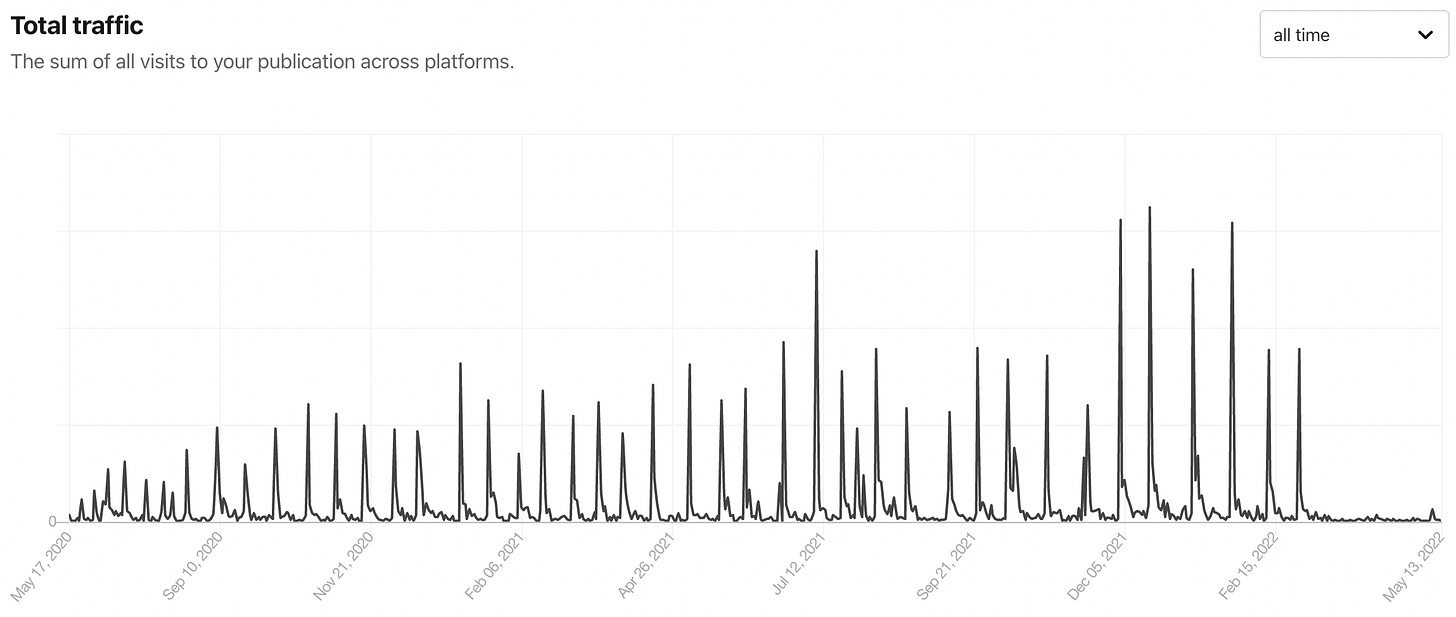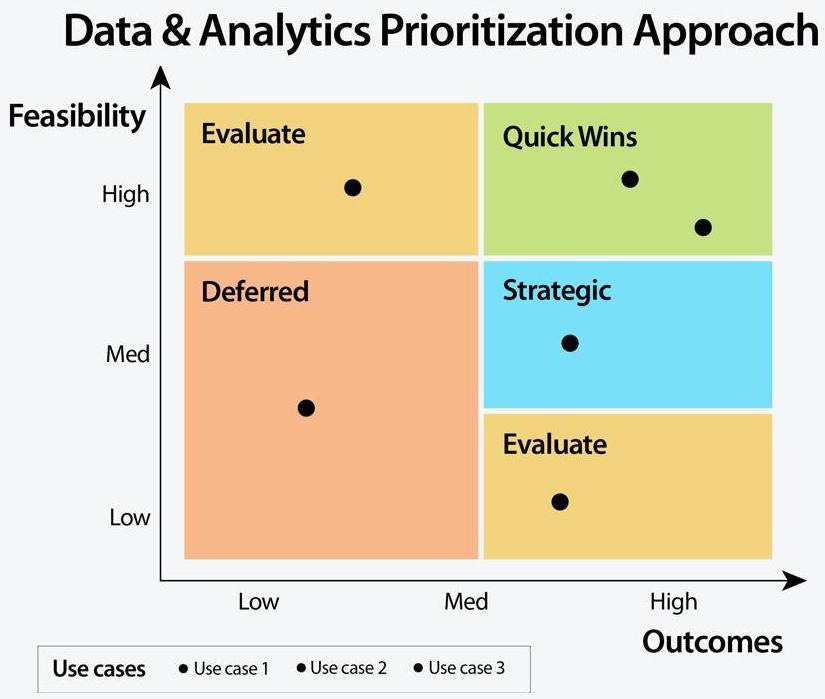5 Steps to picking analytics projects that can transform your business🚀
Hey there,
I’m back with the second anniversary edition of my newsletter (🎉 yay!). You might have noticed the radio silence for the past two months. This is the longest I’ve been away from my newsletter - here’s Substack traffic data to show how I paced it 😀
In March, I took my first flight in two years. For 4 weeks, I huddled together with colleagues for our annual strategy, opened our new office in Hyderabad, and spent quality time with my parents, family, and friends.
This travel felt different, and I was totally engrossed in the present. I skipped most of my social schedules, but it felt good to be living in the moment. It was refreshing to be physically interacting after two years of Zoom-ing.
As they say, take time to ‘stop and smell the roses’. I’m reminding myself to “smell them often” rather than just live off nostalgia - prioritize activities, deliver impact with the 80/20 rule, and slow down a bit.
This newsletter will take you about 5 minutes to read.
I. Spotlight: 5 Steps to picking analytics projects that can transform your business🚀
Building a data and analytics roadmap is quite like planning your financial investment portfolio. You have too many options, and every choice has big implications.
How do you pick a stock portfolio in a bear market? Should you invest in over-heated real estate assets? How about crypto that seems to be in free fall now?
Similarly, organizational leaders find choosing their data and analytics (D&A) projects challenging. Which ones will deliver the best business returns? Will the quick wins really help you in the long run?
(Photo by Eugene Chystiakov on Unsplash)
Embrace these five steps to pick the most impactful D&A projects with outstanding business ROI. We’ll see how each step has striking parallels to investment planning.
Step 1: Identify your business priorities
Never base your financial bets on the killing your friend made from dogecoin. Financial investments are planned by reflecting on personal goals.
Similarly, plans for analytics should never begin with the big data you’ve collected or the AI model that can do cool tricks. Instead, think up organizational goals. Translate your business priorities and stakeholder pain points into a long list of D&A initiatives.
Step 2: Score each initiative on its strategic impact
Once you’ve shortlisted a set of financial instruments for your portfolio, you will assess alignment with your goals, the likely returns/risks, and payout timelines.
Likewise, for every D&A initiative identified, check alignment with strategy. Terrific ideas that don’t add to your business goals are just distractions. Assess the likely business ROI of each idea, user urgency, and whether it’s easy to attribute impact?
Step 3: Assess the feasibility of implementation
Not all financial instruments chosen might be affordable. Some lucrative ones might entail a big upfront cost (say, a high down payment for investment in a rental property).
Many organizations burn their fingers by jumping the gun on AI. If an enterprise has yet to organize its data or is low on data maturity, the best AI solutions will fail. Assess data feasibility, skill availability, implementation time, and change efforts.
(Image: Qualifying data analytics projects on feasibility)
Step 4: Prioritize and build a data analytics portfolio
After assessing the financial instruments for outcomes and feasibility, build your portfolio. But watch out, a good portfolio is not built with just top-performing assets.
Leaders often obsess with quick wins and miss investing in long-term capability. Another common blunder is spreading projects across too many functions. You need a good balance of short vs long term; descriptive, diagnostic, and predictive insights. Ensure synergies between projects in your portfolio.
(Image: Prioritizing the data analytics projects on outcomes vs. feasibility)
Step 5: Plan for disciplined execution
Building a sound financial portfolio is just the first step. Success rests on disciplined execution. For example, pick the right financial platforms, brokerages, and identify a schedule to review and refresh your portfolio.
Once you build a sound D&A roadmap, plan for implementation. Identify the skills and roles needed on your business and technology teams. Invest in the right tools and platforms for delivery. Plan integration into the business workflow and institute governance structures.
Becoming data-driven is a marathon
Planning a robust D&A roadmap takes weeks of effort. Implementing it takes months, and building a culture of data-driven decisions takes years.
Plan your roadmap with a series of incremental projects, not just a few big moonshots. As famed investor Warren Buffett said, “I don’t look to jump over 7-foot bars; I look around for 1-foot bars that I can step over.”
II. Industry Roundup:
1. Article: Your data initiatives can’t just be for data scientists
9 minutes | HBR | Tom Redman
Without buy-in from your company’s rank and file, even the cleverest AI-derived model will sit idle, and “data-driven decision-making” will just go around in circles. Companies need to start seeing regular people as part of their data strategy. Tom Redman shares three suggestions to make data initiatives more inclusive.
2. Report: Data & AI Leadership Executive Survey 2022
16 pages | New Vantage Partners (NVP) | Tom Davenport, Randy Bean
In this annual survey from NVP, I look out for key trends in the data space — AI investment vs. production movement, success in achieving data-driven leadership, the evolution of the Chief Data & Analytics Officer (CDAO) role, and more. Check out this report for a good big-picture view of the industry.
3. Article: Six qualities that drive success in a digital transformation
12 minutes | HBS | Linda A. Hill, Ann Le Cam, Sunand Menon, and Emily Tedards
How did organizations fare on digital transformation during the pandemic? What can we learn from 1,700 leaders, many of whom have been on this journey long before COVID? The article lays out six key characteristics of digitally mature organizations, one of which is a “Culture that’s data-informed, not data-driven”. While data’s role is undeniable, I disagree with the semantic differentiation between the two terms.
III. From my Desk:
1. Podcast: Data Science Strategies In Supply Chain
20 minutes | The Digital Supply Chain Podcast
How do you apply data science in the supply chain industry? What are some examples and challenges executives face? In this podcast episode, Tom Raftery and I discuss these questions. I share examples from our work in this space.
2. Article: Are You Guilty of These 3 Biases That Kill Most Startups?
6 minutes | Entrepreneur
In my latest for Entrepreneur, I share three key failure patterns in startups, based on the book "Why Startups Fail" by Prof Tom Eisenmann of HBS. Check out the article for industry examples on each pattern and tips for tackling them.
3. Mentoring: Analyzing health disparities from adverse childhood events
3 minutes | Penn State University
How do adverse events in one’s childhood impact their health and long-term wellbeing? A student team at Penn State University found the answers from data with guidance from Dr. Jennifer Kraschnewski of Penn State College of Medicine. Over 12 weeks, I mentored the students on delivering actionable insights in this project.
When your project is not ready, but the client wants to see a demo - video meme 🤣
Thank you for subscribing and reading the newsletter. I appreciate your attention,
Ganes.
PS: Did someone forward this to you? You can subscribe here.
My Website | LinkedIn | Twitter | YouTube
I’m Ganes Kesari. I publish ‘Data-Driven Future’ to help understand how data shapes our world, explore key trends, and explain what they mean for you today. I speak and write to demystify data science for decision-makers and organizations.
Recent Issues:










